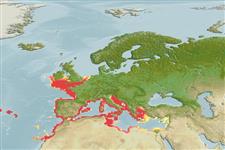Common names from other countries
Classification / Names / Names
Namen | Synonyme | Catalog of Fishes (gen., sp.) | ITIS | CoL | WoRMS
Environment: milieu / climate zone / depth range / distribution range
Ökologie
; tiefenbereich 10 - 180 m (Ref. 113223). Subtropical, preferred 9°C (Ref. 107945); 53°N - 27°N, 32°W - 36°E (Ref. 114316)
Eastern Atlantic and the Mediterranean.
Length at first maturity / Size / Gewicht / Alter
Maturity: Lm ? range ? - ? cm Max length : 11.0 cm SHL Männchen/unbestimmt; (Ref. 109255); max. veröff. Alter: 40 Jahre (Ref. 8702)
An active suspension feeder (Ref. 96376). Infaunal, found on sandy substrates (Ref. 113223).
Life cycle and mating behavior
Geschlechtsreife | Fortpflanzung | Ablaichen | Eier | Fecundity | Larven
Members of the class Bivalvia are mostly gonochoric, some are protandric hermaphrodites. Life cycle: Embryos develop into free-swimming trocophore larvae, succeeded by the bivalve veliger, resembling a miniature clam.
Gaspar, M.B., M.N. Santos, P. Vasconcelos and C.C. Monteiro. 2002. (Ref. 2736)
IUCN Rote Liste Status (Ref. 130435)
CITES Status (Ref. 108899)
Not Evaluated
Not Evaluated
Nutzung durch Menschen
Fischereien: kommerziell
FAO - Fischereien: landings | FishSource | Sea Around Us
Tools
Internet Quellen
Estimates based on models
Preferred temperature
(Ref.
115969): 10.8 - 21.5, mean 18.7 (based on 822 cells).
Widerstandsfähigkeit
mittel, Verdopplung der Population dauert 1,4 - 4,4 Jahre. (K=0.21-0.38; tmax=40).
Verwundbarkeit
Low vulnerability (10 of 100).
